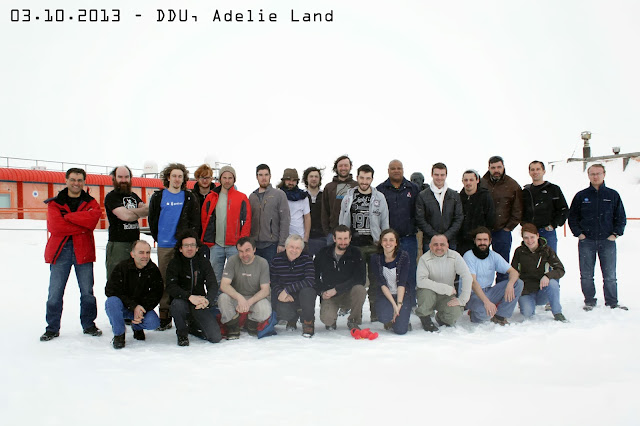For my 365th day at DDU station, on November 8th, I throw the meteorological baloon for the first time. Meteorologists at the base throw such a baloon every day to mesure various parameters in the atmosphere (temperature, pressure, wind speed, etc.), to improve meteorological models.
So, one entire year now ! And few more months still. Summer started again: a lot of adelies, less emperor penguins, a lot of petrels, and a lot of humans ! We are now 48 persons at the base I think, and will be much more when the next boat arrives.
Summer time, and planes arrivals were also a great opportunity to get few boxes of fresh fruits and vegetables. Unfortunately not enough, we will have to wait a bit longer, we already ate them all...
Soon, a post on emperor pengiuns breeding cycle !
November 28, 2013
October 11, 2013
Antarctic Film Festival
From July
to September, time flew very fast. Bad weather conditions marked most of the weeks,
but fortunately, the Antarctic film festival began early August. Every year all
(or most) Antarctic and Subantarctic stations participate in this event by
producing one or more movies. Subsequently the best movies are elected
internationally by these same stations. There are 2 categories for the movies:
open, and 48h hours. As the name suggests, the open category can include any
type of movie with the only constraint of 5 minutes duration. For the 48h
category, it is a bit more complicated: all stations got, on August 2nd,
the same 5 elements to include in their 48h movie (maximum duration 5 minutes
again). The project had to be submitted on August 4th. The 5 elements this year were: the
gingerbread man, a real sneeze noise, a bath tub, a ping pong ball, and the
sentence “Voulez-vous coucher avec moi ce soir ?”.
We had a
lot of fun preparing the 2 movies we submitted, and watching the other stations
pieces of art.
To have a
look at the movies, follow the links:
DDU station
movies:
-
Open :
- 48h:
All movies
for the festival:
https://drive.google.com/folderview?id=0B6xKzE6p5KMFX0FrZXJlV3lkTDQ&usp=sharing
One year after…
Every year,
the French polar institute organize a seminar with all people preparing a
winter-over in the French Antarctic and subantarctic territories (Kerguelen,
Crozet, Amsterdam, and Adelie land). By tradition, one year after we take a
picture at the base, to show how hairy we got !
July 13, 2013
An Adelie's Life...
Wawwww I
haven’t been writing in my blog in a long time. Thanks to a really good friend
who motivated me, I will start again (hopefully more often)!
Last
summer, the station was full of adelie penguin, petrels, skuas. Now they are
all gone, and the emperor penguins came back.
Before
presenting the emperors, I wanted to sum up life in Antarctica for an adelie
penguin. OK it is not the season anymore, but afterall, they come back in
October!
In October,
males arrive first, and choose a nest for the coming reproductive season. Their
nests are located more or less at the same spot every year. Their nests are
made of small rocks; this allows the snow to melt faster and consequently to
avoid the egg or the chick to be wet and probably die.
Snow can be
a serious problem for them, sometimes covering them totally. But it also
hydrates them which is critical for their survival ashore.
Afterwards,
the females arrive, and courtship display starts. They sing together, heads up,
flippers opened. I cannot say much about this period, as I arrived too late in
November. Once in pair, they will continue these courtship calls anytime they
met again (after a travel at sea), and with the chick as well. Calls help them
recognize each other, together with visual cues.
Once they
copulated and the female layed 1 or 2 eggs, she will leave to fish, and the male
will incubate the egg for 15 to 20 days.
Then the
female will come back and they exchange role. Male can be very durty after such
a long time spent ashore. You can differentiate them from coming females just
by their plumage color.
Once the
egg hatches (December), everything is going very fast!
Especially chick
growth. At the beginning, the chick is too small, and stays below its parent.
The parents exchange guarding shifts.
But once
the chick is thermically emancipated, it gathers with other chicks in small
huddles, and the parents are both at sea fishing, and coming back more often to
feed him.
In
February, the chicks molt, to get adult plumage.
When the chicks are
ready (mid-February), they leave for their first swimming attempt. They look
terrified until they put their head below the surface. And then they swim
naturally.
An immature
adelie penguin, around 1 year old still do not look as an adult, and miss the
black spot on the chin.
Adults come
back ashore to molt as well late February and March, and they leave as well
eventually, to come back the next season.
I hope I
summarized well an adelie life in Antarctica!
At DDU, as
in all other Subantarctic and Antarctic stations, we celebrated Midwinter on
June 21st. We extended the celebration between June 18th
and June 24th. It is a great opportunity to unify the group, play
games outside when the weather is ok, and enjoy the fact that we spend
already/only half the time planned at DDU!
It is too
late to wish you a happy midwinter, so happy post-midwinter and enjoy your
summer in Northern Hemisphere !
Subscribe to:
Posts (Atom)













































